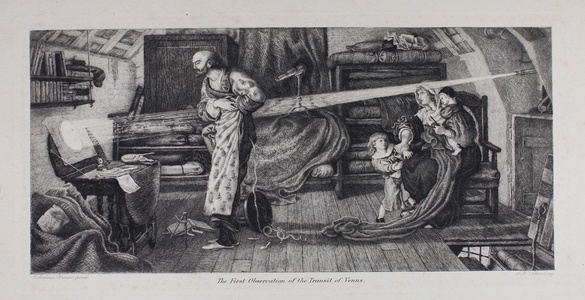| Method | Etching |
| Artist | George Wooliscroft Rhead after Ford Madox Brown |
| Published | c.1893 |
| Dimensions | Image 125 x 270 mm, Plate 150 x 290 mm, Sheet 250 x 350 mm |
| Notes |
A scene showing the first observed transit of Venus by the cloth merchant William Crabtree on December 4th 1639. The original is from a series of frescoes by Ford Madox Brown called the Manchester Murals. Crabtree is seen to the centre of the image viewing the transit of Venus being shone through a telescope camera obscura set up and projected on the wall opposite. His wife is seen seated to the right, holding a small child in her arms, and holding back a small child by the arm. The Manchester Murals are a series of twelve paintings by Ford Madox Brown in the Great Hall of Manchester Town Hall and are based on the history of Manchester. Following the success of Brown's painting Work he was commissioned to paint six murals for its Great Hall. Another six murals were to be completed by Frederic Shields who later withdrew, leaving Brown to complete all twelve works. The murals were begun in 1879, towards the end of Brown's career, but were not completed until 1893, the year he died. George Wooliscroft Rhead (1855-1920) was a painter and etcher of genre and classical subjects. He studied art under Legros and Ford Maddox Brown, and exhibited at the leading London galleries from 1873, mainly at the R.A. In 1883, he was elected to the R.E. Ford Madox Brown (1821-1893) was an English painter whose work is associated with that of the Pre-Raphaelite Brotherhood, although he was never a member. Brown studied art from 1837 to 1839 in Bruges and Antwerp, Belgium. His early work is characterized by sombre colour and dramatic feeling suited to the Byronic subjects that he painted in Paris during 1840–43, such as Manfred on the Jungfrau (c. 1840) and Parisina's Sleep (1842). In 1848 Brown briefly accepted Dante Gabriel Rossetti as a pupil, and in 1850 Brown contributed to the Pre-Raphaelites' magazine, Germ. Like William Holman Hunt, Brown painted in the open air to obtain naturalistic accuracy. His most famous picture, Work (1852–63), which can be seen as a Victorian social document, was first exhibited at a retrospective exhibition held in London (1865), for which he wrote the catalogue. He also worked as a book illustrator with William Morris, produced stained glass, at, among other sites, St. Oswald's, Durham (1864–65), and between 1879 and 1893 completed a series of 12 murals for the Manchester town hall, depicting scenes from the city's history. Published state with printed title. Condition: Some light staining to sheet margins, not affecting image. |
| Framing | unmounted |
| Price | £290.00 |
| Stock ID | 48420 |

